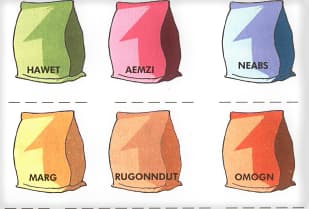Give two examples of multiple fruits.
Important Questions on Flower to Flower
Ramu the farmer has to pack the seeds into these sacks but his son Bapi has mixed up the spellings. Write the correct name of the seed in the space given.

Give two examples for plants with two cotyledons.
How many types of seeds can you collect? Where will you find them? Each of you should try to collect as many different types of seeds as you can. After that, put all the seed collections together. Now observe these seeds carefully — their shapes, sizes, colours, textures (smooth or rough). Make a seed chart to put up in the class.
Which was the smallest seed and which was the biggest seed in your collection?
What are the similarities and differences between?
Jowar and Moong.
Explain the following images in your own words.
Write the quadrants in which the following points lie:
How many types of seeds can you collect? Where will you find them? Each of you should try to collect as many different types of seeds as you can. After that, put all the seed collections together. Now observe these seeds carefully—their shapes, sizes, colours, textures (smooth or rough). Make a seed chart to put up in the class. You can start with a table like this.
| Name of the seed | Colour | Shape | Texture |
| Rajma | Reddish brown |  |
Smooth |
How many types of seeds can you collect? Where will you find them? Each of you should try to collect as many different types of seeds as you can. After that, put all the seed collections together. Now observe these seeds carefully—their shapes, sizes, colours, textures (smooth or rough). Make a seed chart to put up in the class.
Did you keep aniseed (saunf) and cumin (jeera) in your list?



